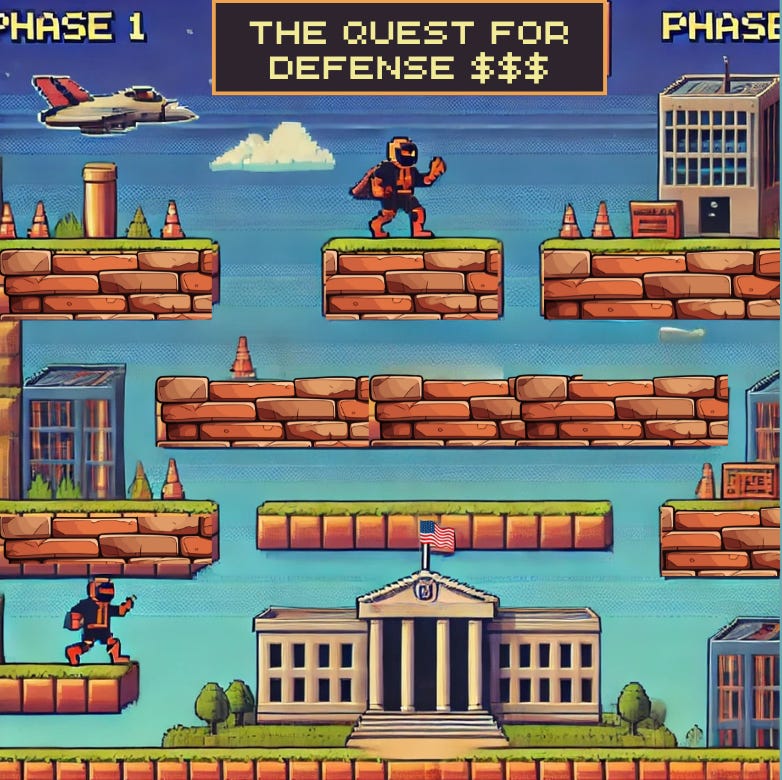The Quest for Defense $$$
Selling to Defense is often like mastering levels in a video game - the DoD has its own language, characters, unforeseen obstacles and progressively complicated levels
Mario explores the Mushroom Kingdom to defeat Bowser and rescue Princess Toadstool, gathering coins and overcoming Goombas, Koopas and Bullet Bills. Sonic the Hedgehog collects rings and finds routes to get through a series of levels, seeking to reach his archenemy, Dr. Robotnik and ultimately free imprisoned animals. Link searches the land of Hyrule to collect fragments of the TriForce of Wisdom to rescue Princess Zelda, but quickly learns that he must survive increasingly more difficult quests to prevail.
The experience of an entrepreneur selling to the U.S. military is not unlike that of a video game player. The Defense Department and its acquisition system exist in their own universe, with its own language, characters, unforeseen obstacles and progressively complicated levels that players must surmount. (In fact, “The Pentagon” itself sounds like a game world.) Entrepreneurs new to the universe may find themselves lost, confused, or facing setbacks as they navigate the Pentagon’s acquisition bureaucracy. They must contend with a daunting number of people, an unfamiliar social ranking system and a new language – from acronyms like SBIR, JCIDS, and OTA to military phrases like “force multiplier” and “situational awareness.” They must find their way through over 4,000 pages of acquisitions guidance, develop a network of allies who can help them get to the next level, the Technology Readiness Level to be exact, where higher levels unlock additional contracts and new customers.
Over the next few posts, we will explore the byzantine world of Pentagon acquisitions–through the most relevant analogy–video games. This is certainly not meant to trivialize the process–rather, to demystify it and illuminate some of its often-overlooked and misunderstood features. For entrepreneurs creating products with applications to the military, the analogy has several advantages. First, it helps shed light on what is often an insider-only game given the entrenched nature of procedures, offices, and even individual stakeholders, as well as the building’s historical reliance on a few major companies.
The video game metaphor also clarifies a seemingly obvious reality that entrepreneurs nonetheless often overlook when navigating the bureaucracy: The process is both sequential and cumulative. A product matures by meeting a series of milestones, and each new step builds on previous work. Entrepreneurs must get stakeholder buy-in at each level which is necessary for reaching the next one and value earned in the previous step must be leveraged in the next. Like in video games, it is only after achieving several milestones that companies are able to secure a long-term commitment that their product or service will be integrated into the DoD’s plans. There are no cheat codes, and there are no shortcuts for checking off each milestone before getting to the final, coveted level of closing the deal by becoming a program of record.
Finally, the idea of DoD acquisitions as a game unlocks an important insight: those who succeed at selling are not necessarily those who have a retired admiral or general on their payroll or even the best technology. The victors are those who fully integrate into the universe--abandoning their prior assumptions to learn the unique Pentagon world, developing a bespoke network of champions/supporters, and working to educate potential customers of the value their product provides.
Above all, studying this universe and each of the quests within the game is meant to show tech professionals that the complex, often daunting Pentagon universe should not be an object of either consternation or fear. The bureaucracy, while imperfect, is set up according to a certain logic focused on preventing worst-case scenarios like failure and fraud. And while the inner workings of the Pentagon can be frustrating and overwhelming, a commitment to learning and understanding them can unlock significant opportunity.
The next post will pick up with a look at the multiverse/realm of the Pentagon and what makes selling to DoD so different from operating in the commercial market.




Very fun read Jeff. I’m surprised I never thought about it this way when I was learning the system from the inside. Also, solid references: Mario, Sonic, Zelda/Link. Games of yesteryear